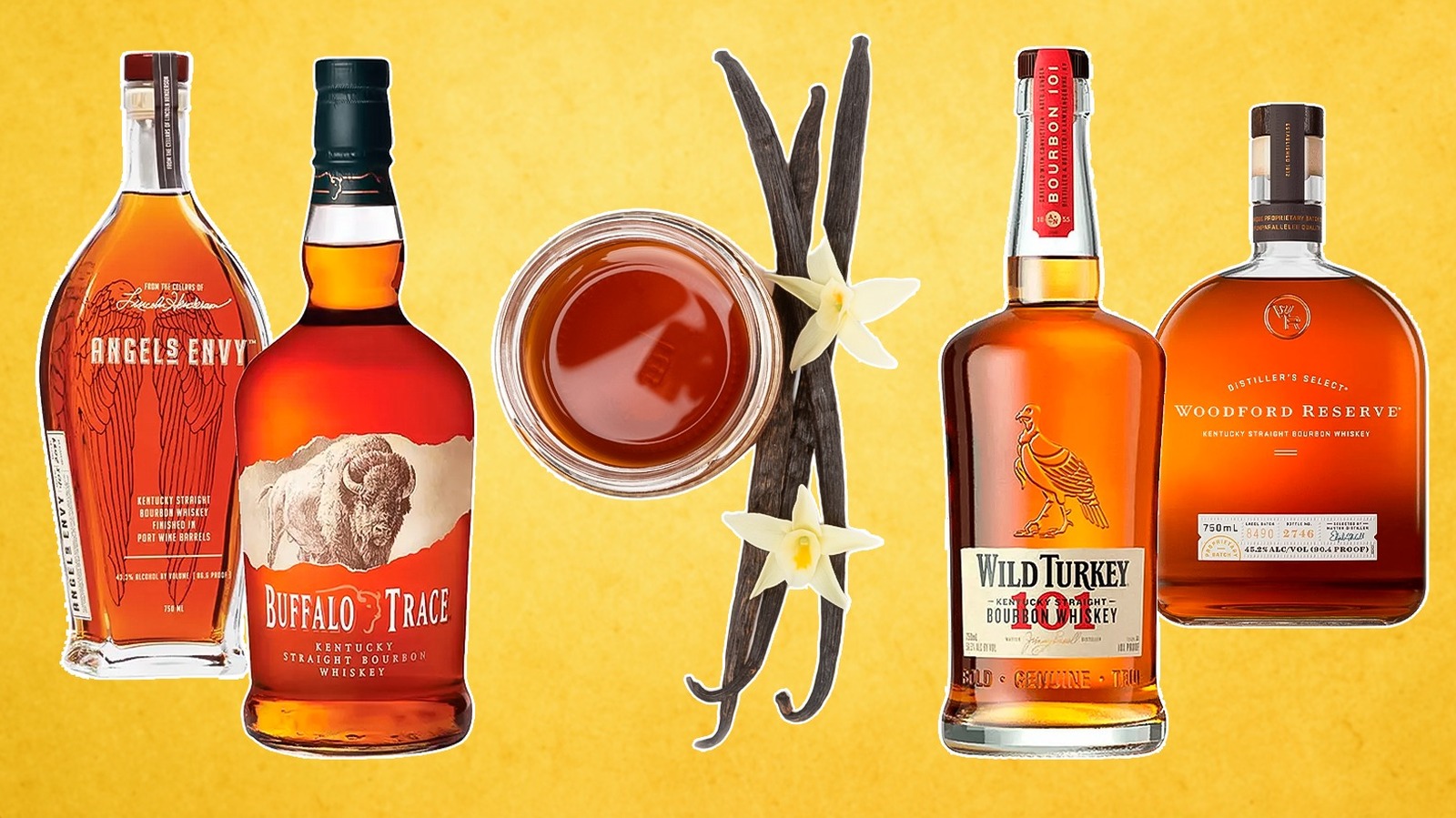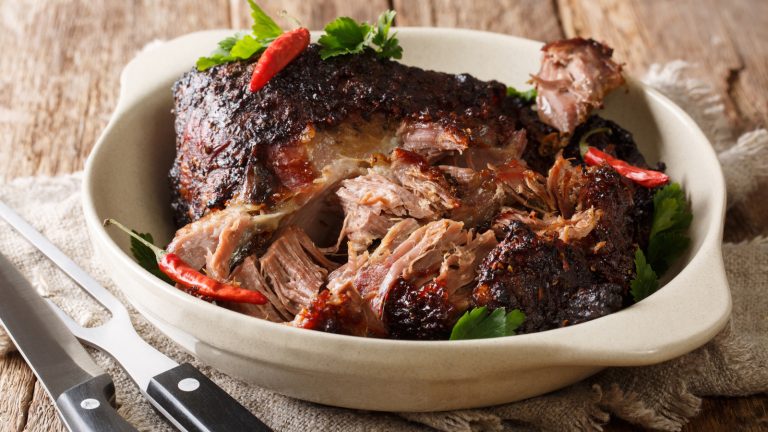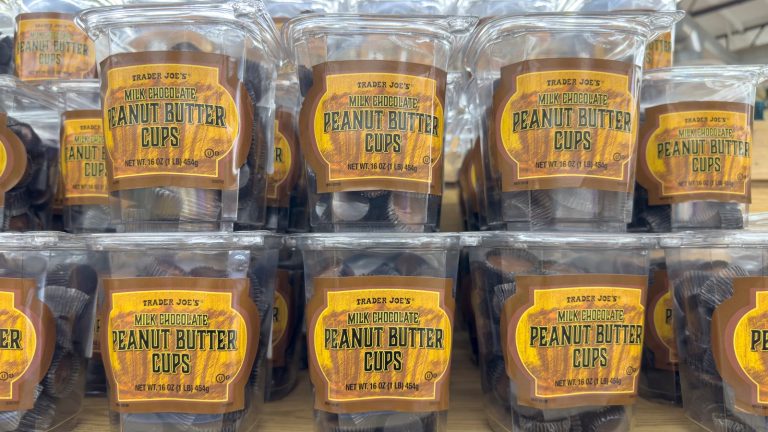When it comes to baking, there are a few basic ingredients that will almost always be included in a recipe: butter, sugar, eggs, flour, vanilla. While only a teaspoon or two of vanilla extract is usually called for, a small bit adds depth to your baked good and enhances other, already present flavors. The easiest way to add a splash, of course, is to buy a bottle of imitation or real vanilla. Imitation is never going to be as good as the real thing, but genuine vanilla can come with a hefty price tag thanks to the cost of the beans. But what if you didn’t need to buy a bottle? What if you could make your own?
A recipe of just two ingredients — bourbon and vanilla beans — it couldn’t be easier. Sure, you’ll have to wait a few months before the extract is ready to use, but the end result is definitely worth the wait. Now you just have to decide which bourbon to use as your base. With so many different brands available, we reached out to a few experts to get their recommendations on which were the best.
Our host of bartenders and beverages director delivered 13 of the best bourbons to use for making vanilla extract. No matter what you choose to work with, one thing both Joseph Oddo, beverage director at D.C.’s Jack Rose Dining Saloon and Chase Henry from the Wiseguy Loung agree upon is that you definitely want something higher proof. “100 and up is best, though over 120 is where things are really going to go crazy,” Henry says.
Buffalo Trace
One of the more recognizable bottles on store shelves, Buffalo Trace has been around for decades. Named after the buffalos that ran across the wild frontiers of the Midwest to the Kentucky River banks where the distillery has been standing for over two centuries, this bourbon has a mashbill that includes “a healthy amount” of corn, rye, and malted barley. The whiskey is then aged in new oak barrels for several years until the distillers deem it worthy of the Buffalo Trace moniker.
While there are many bourbons the Buffalo Trace distillery has produced, it’s the flagship bottle that both Colin Dennis, lead bartender at Asheville’s Wildwood Still, and Rebecca Johnson, the bar manager at Coltivare, Houston, say are the best choice for crafting your own vanilla extract.
Johnson believes it’s because of the bourbon’s “many hints of vanilla” while Dennis tells us that it’s the whiskey’s “complexity and well-balanced sweetness, along with its notes of vanilla, brown sugar, and spice” that make it a great choice for your homemade vanilla extract. Dennis further explains that those notes deliver “a rich, natural [vanilla] flavor without being overpowering.”
Wild Turkey 101
Another well-known bourbon, Wild Turkey has officially been around since the 1940s. We say officially because while the whiskey has been distilled and enjoyed since the late 1800s, it wasn’t called Wild Turkey until an executive at the distillery shared his bourbon with some friends while they were hunting wild turkeys. Crafted by master distiller, Jimmy Russell, this bottle gets its name because the bourbon has an ABV of 50.5 percent or 101 proof. That higher proof is why Chase Henry believes it’s a great base for mixing up your own vanilla.
“It’s a classic and for making an extract you generally want something higher proof with some power behind it. 101 fits that bill nicely,” Henry explains. “It already has a nice base of strong vanilla/caramel flavors, with a hint of orange and just a little funk.”
The master of bourbon believes the vanilla beans will infuse the bourbon “nicely” while making an “extract that will be just a bit different and something new to any baking you use it in.” Henry also likes this bourbon because of it’s cheaper price tag. At around $25 per bottle, you won’t feel so bad using it as the base of your extract instead of the base of your favorite bourbon cocktail.
Knob Creek 9 Year Single Barrel
While Knob Creek has six different bourbons under its name, only two made our list. The first is this 9 year single barrel, a unique experience where each and every bottle comes from its own barrel. Normally classic bourbons are created when the distillers mix a variety of barrels together to get the perfect blend. But a single barrel bourbon means that the bourbon in those few bottles all come from one barrel and one barrel only.
Just because Knob Creek is a newer bourbon, only appearing on the scene in 1992, doesn’t mean it isn’t a popular spirit. In fact, even though the bourbon has only been around for about 40 years, it can be spotted on shelves all across the country. Even though this 9 year single barrel may take a little more effort to find, Joseph Oddo swears the hunt will prove fruitful in the end.
Since the beverage director of Jack Rose’s Dining Saloon believes that you should use a bourbon “that’s high proof and barrel driven” when crafting your own vanilla extract, it makes sense that he’d recommend this particular bottle. “Bottled at 120 proof, it carries a good amount of wood influence that would translate well for turning vanilla beans into an extract,” he says.
Elijah Craig Small Batch
Several bourbons on our list date back to the 18th century, but Elijah Craig may have the most interesting start as it was created by a Baptist preacher. Elijah Craig may have been imprisoned for his beliefs, and had such a devoted following that his congregation would stand outside the prison to hear his sermons, but it was his hobby of distilling whiskey that made the preacher famous.
Often called the father of bourbon, Craig’s whiskey became the popular spirit it is thanks to the preacher’s unusual decision to age his whiskey in charred oak barrels. While it’s common practice to age bourbon in new charred oak barrels today since it’s part of the US bourbon law, it was unheard of back in the 1700s. Craig’s decision to use charred barrels stems from the way the char changed the whiskey’s flavor. It’s a flavor that has continued to make Elijah Craig the popular bourbon it is, and the reason why some bartender thinks it’s a great base for your vanilla extract. “Its layered taste and smooth character, accompanied by its notes of vanilla, caramel, toasted oak, and warm spices, would add a pleasantly woody, and slightly toasty warmth to the vanilla extract,” explains Colin Dennis.
Woodford Reserve
One of the most popular bourbons around, a bottle of Woodford Reserve can be spotted immediately when nestled next to other bourbons thanks to its unique shape. While all bourbons must have a mash bill that’s at least 51 percent corn, Woodford goes above and beyond with a mash bill that is made up of 72 percent corn, 18 percent rye, and 10 percent malted barley. The official bourbon of the Kentucky Derby, Woodford has been crafted in the same distillery (now a national historic landmark), with the same mash bill, water, fermentation, and distillation process in Versailles, Kentucky since 1812.
Even though Woodford has several different bourbons under its moniker, it’s the flagship bottle that the bar managers recommend when crafting your own vanilla, thanks in no small part to its “decent price point” and the fact that it’s “readily available in just about every supermarket [or] liquor store.” But those aren’t the only reasons Ben Bozeman, the bar manager at the Lucky Cheetah in Portland, Maine, says this a great option. Flavor plays a big part as well. “The flavor profile is complex, with notes of vanilla and toffee,” he explains. “It pairs really nicely with the vanilla beans and yields a great final product.”
Evan Williams Bottled-in-Bond
Another high quality bourbon that’s easy on the wallet, Evan Williams Bottled-in-Bond is part of the well known Evan Williams bourbon family. Also created in the 19th century by its namesake, Evan Williams has several bourbon varieties but it’s specifically the Bottled-in-Bond that Colin Dennis recommends as the base for vanilla.
What sets this bottled-in-bond bourbon apart from other bourbons, other than its bright white label, is how it’s made. Unlike other bourbons which can be made by several distillers and aged for anywhere from two to 10 years (or more), a bourbon that’s officially bottled-in-bond has to follow the Bottled in Bond Act of 1897. The bourbon can only be made by one distiller at a single distillery and has to mature in new charred oak barrels for four years. No more, no less. It also needs to age in a bonded warehouse and be distilled in a single distilling season.
That extra attention to detail leads to a 100 proof bourbon that Dennis says “will help extract and intensify the vanilla flavors, while its rounded sweetness and spicy oak notes would add depth, ensuring the vanilla extract has a bold, robust, and full-bodied flavor.”
Knob Creek Cask Strength
The second Knob Creek on our list is a new edition to the Knob Creek family, having been released just a few months ago. The company released two different cask strength whiskeys, a rye and a bourbon, but it’s the bourbon that Wiseguy Lounge bartender, Chase Henry, says is a great base for vanilla extract; not just because of its flavors but because of its 124.6 proof.
“This whiskey has strong, deep notes of rich vanilla, caramel, some woodiness and a hint of roasted peanut,” Henry says. “A very enjoyable whiskey, the proof will help in pulling out the vanilla even better than the Wild Turkey. [The vanilla is] going to be a rich bold extract, and a little is going to go a very long way.”
What makes this bottle different from its counterpart is that it’s a cask strength bourbon. That label means that the liquid in the bottle has come directly from the barrel. Typically when bourbons come out of the barrel, distillers dilute the distillate to bring down the proof and achieve the flavor they’re searching for. But when a bourbon is cask strength, the distiller likes the flavor and texture of the bourbon enough that they choose not to add any water and place that luscious liquid straight into the bottle.
By not diluting the spirit, you end up with not just a stronger bourbon but a bourbon that tends to be a little pricier. Still, Henry says that even though it’s “a bit more expensive… it’s still fairly reasonable, especially for a 120 proof bourbon.”
Heaven Hill Bottled-in-Bond
The Heaven Hill distillery may distribute several well-known bourbons, but it’s the namesake bottle that Ben Bozeman says is a great option for any vanilla extract. “In my opinion, one of the best bottles on the market. Its flavor profile is a great mix of vanilla and honey, with just a subtle bit of rye spice.” Unlike other bottles coming out of the Heaven Hill distillery, the recipe for the Heaven Hill bottled-in-bond has been the same ever since it first came off the assembly line in 1939. And after winning numerous awards, including World Whiskey of the Year in 2023 and Double Gold in 2024, it’s easy to understand why.
Aged for 7 years, this bourbon clocks in at a perfect 100 proof, and our experts believe a higher proof means a better vanilla. Sure, it may not be “the cheapest bottle out there, but it won’t break the bank,” and Bozeman promises “the finished article will be unique and amazing.”
Angel’s Envy
Angel’s Envy is one of the younger bourbons on the list. While interesting, that’s not the reason Coltivare’s bar manager, Rebecca Johnson, picked it. She recommended Angel’s Envy as a base for vanilla because of how it’s made. Yes, it still follows all the standard rules that need to be followed to be a bourbon, including a mash bill that uses at least 51 percent corn and is aged for at least two years in charred new oak barrels. But then Master Distiller, Lincoln Henderson, and his son Wes, the brains behind the spirit, decided to take their recipe further.
Sure, they could have quit with just one barrel like a lot of other bourbons on the market, but where’s the fun in that? These two decided to do something a little different. They decided to age it for an extra six months. But this second aging doesn’t occur in another new charred oak barrel. No, this second aging, also known as double maturation, takes place in 60 gallon port barrels from Portugal. Johnson believes it’s those port barrels that give this bourbon “great hints of smoky raisins, chocolate, and maple,” making it another great choice.
Cathead Old Soul Bourbon
The first legal distillery in Mississippi, Cathead took its name from a term of respect coined by the original blues musicians of the area and often used for those in the arts from musicians and writers, to painters and everything in between. It may seem odd that Cathead wasn’t established until 2010, but when you consider that Mississippi was the last state to repeal prohibition in 1966 (yes, 33 years after the 21st amendment was added to the U.S. constitution), it’s not surprising that it took the Southern state over 40 years to establish its first legal distillery. As such, bourbon isn’t the only spirit Cathead creates. It also has several vodkas, gins, liqueurs, and RTD’s on its docket. But it’s Cathead’s Old Soul small batch bourbon that the beverage director at Rêve says she “loves for vanilla extract.”
What makes Old Soul unique is that its mash bill is a blend of two high-rye whiskeys distilled in both Indiana and Mississippi and then blended together at Cathead. As someone who admits she “really loves rye” it’s understandable why Old Soul was one of Chelsea Cheyenne top picks. The beverage director at Birmingham, Alabama’s Rêve calls it a, “It’s a smooth and well-rounded bourbon.” And if you have some leftover after you create your vanilla, Cheyenne tells us that the bourbon is “also perfect for cocktails that use vanilla in a savory way,” something she does frequently at Rêve.
Old Forester 1910
An obvious choice when making vanilla is reaching for a bourbon that Joseph Oddo says “would naturally have its own vanilla quality.” He believes Old Forester 1910 has that quality. Created in 2014 as part of Old Forester’s Whiskey Row series, the series was meant to treat Old Forester fans to a tasty trip down memory lane by using similar whiskey recipes to those created in 1870, 1897, 1910, and 1920.
The 1910 is a recreation of the Old Fine Whisky that was crafted in 1910 after a fire shut down the bottling line. Luckily the most recent batch had just been dumped and was ready to be bottled. But since the fire shut down the assembly line, the crew had no bottles in which to place the bourbon. So, they did the only thing they could: pour the spirit into a second barrel to rest while the crew rebuilt the line.
Once the line was repaired, the distillers poured out the bourbon and discovered they had created a whiskey that was even better than the original. A whiskey worthy of a new bottle and a new name: Old Fine Whisky. A whiskey that Oddo describes as “a rich, double barreled expression [that] packs its own fun punch, and would do well for those looking to ‘double down’ on their vanilla!”
Yellowstone Select Bourbon
Even though Yellowstone Select bourbon is a relative newcomer to the whiskey world, only being introduced in 2015 by Stephen Beam, the recipe is a recreation of the original formula which was created back in 1872 by D.H. Taylor & John T. Williams after President Ulysses S. Grant signed the Yellowstone National Park Protection Act and created the first national park in the United States.
Because the national park is so important to the brand, in 2018 Beam and his team joined forces with the National Parks Conservation Association (NPCA) and now a portion of every bottle sold goes directly to the NPCA. To date, Yellowstone has donated $1,000,000 to help preserve the national park.
Those are all great reasons to add this bottle to your shelf at home. But that’s not why Chelsea Cheyenne recommended it. She says it’s because of its unique flavor. Yellowstone Select is “a little wild card for vanilla extract because of the ripe and bright notes of cherry in the spiciness. I’m a huge fan of cherries of course,” she continues, “so I feel like it makes a lovely vanilla extract for holiday or even high summer desserts.”
New Riff Single Barrel
A craft distillery that enjoys riffing on the classic Kentucky spirit, New Riff doesn’t just create its own special spin on bourbon and rye, Ken Lewis and his team also create spins on malted rye whiskey and gin. But it’s New Riff’s single barrel bourbon that the beverage director of the Jack Rose Dining Saloon believes is the best bottle to use when mixing up your own vanilla. “Bottled at cask strength, you get a good, strong and rounded whiskey to pull out those vanilla flavors,” Joseph Oddo explains.
The Single Barrel is a high rye bourbon with a mash bill of 65 percent corn, 30 percent rye, and 5 percent malted barley that’s aged for four years in new charred oak barrels. But what makes this bourbon really stand out is that each bottle has its own flavor and proof since each barrel the bourbon comes from is going to be slightly different. Those nuances create a bourbon that Oddo says is “very baking spice driven and well rounded, making it a good option for a more esoteric extract.”





